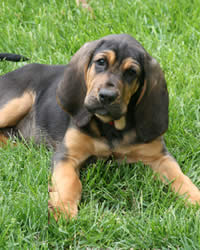Bloodhound Dog Breed Information
 |
| ||||||||||||||||||||||||||||||||||||||||||||||||||||||||||||||||||||||||||||||||
Bloodhound – Just The Facts
| Do you own this Dog breed?Please tell us about it in the form at the bottom of this page. Need a good Puppy Name?Visit our Puppy Names page for 1000s of top dog names. |
General Description
What makes the Bloodhound a renowned breed is its excellent sense of smell. These hound dogs can track scents with such precision that you will often see them used as assets in law enforcement and police investigations. They are one of the oldest sniffing breeds in canine history.
Origin and History
A lot of people think Bloodhounds have a nose for blood. In reality, the breed name pertains to the fact that the dogs are blooded hounds, since they are of noble descent.
Eighth-century Europe served as home to the breed. In the 11th century, William the Conqueror brought these dogs to England and in the following century, Belgian monks took charge of their breeding.
America finally welcomed the breed in the mid-19th century. Despite their calm demeanor, the dogs were seldom viewed as pet material.
Bloodhound Temperament
Bloodhounds are gentle, playful giants at home and curious, tireless sniffers outdoors. They are extremely affectionate and friendly to children but somewhat reserved with strangers. Although they do not always bark, prepare your ear plugs when they do!
This dog breed tends to act dominantly around other male dogs and small animals. Outdoors, the breed’s curiosity takes the forefront and can even lead the pooch to road accidents.
Care, Grooming, Diet & Exercise
Living Environment – The breed requires a large acreage to roam, and secure fencing is crucial. It’s very hard to call the dog off once it begins sniffing around. A cool and moderate atmosphere works well for them.
Give them a soft bed to lie on and remember to check the weather or the room temperature because they are not that tolerant to heat. Keep them away from areas where you store your favorite furniture as they have a tendency to chew off things whenever their exercise and socialization needs aren’t met.
Grooming – Except during shedding seasons, these dogs have minimal coat care requirements. Be warned though that despite your efforts to groom them, the dogs will always exude a distinctly houndy odor. Ensure that their ears, dewlap and facial folds are clean, well moisturized and free from infections.
Diet & Exercise – These large hound dogs are prone to obesity and gastrointestinal problems. It is essential that you schedule small feedings twice or thrice a day only. The recommended diet consists of poultry, and some fruits and grains. As the dog tends to slobber, you may have to frequently refill their bowl with clean drinking water.
If you are the busy career-oriented individual or the certified couch potato, this large dog breed may not be for you. The breed needs a minimum of 90 minutes of daily exercise. This can entail leash-free romping in a secured yard or a supervised game or jogging outdoors.
Health – This large dog breed lives a relatively short life. A number of health conditions are associated with the breed, and these include elbow dysplasia, chronic heart diseases and stomach problems. Apart from their allergic tendencies, the dogs may also be sensitive to anesthesia and can only tolerate it in small dosages.
Bloodhound Trainability
Training a Bloodhound is no turf for newbies. They possess a stubborn streak and a laid back attitude, which make conventional obedience training and housebreaking a challenge. Once a scent interests the dog, it is nearly impossible to command the pooch to pay attention to you.
Using treats to reinforce a behavior will surely help in the training process. If there is an area where they excel, though, that would obviously be trailing.
Do you own this dog breed?
Please tell us about your experience with a particular dog breed, and upload a picture if you have one!
Return to AKC List of Dog Breeds ranked by Popularity
Return from Bloodhound back to Alphabetical List of Dogs Breeds page